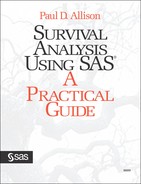Conclusion
It’s no accident that Cox regression has become the overwhelmingly favored method for doing regression analysis of survival data. It makes no assumptions about the shape of the distribution of survival times; it allows for time-dependent covariates; it is appropriate for both discrete-time and continuous-time data; it easily handles left truncation; it can stratify on categorical control variables; and it can be extended to nonproportional hazards. The principal disadvantage is that you lose the ability to test hypotheses about the shape of the hazard function. As we’ll see in Chapter 8, however, the hazard function is often so confounded with unobserved heterogeneity that it’s difficult to draw any substantive conclusion from the shape of the observed hazard function. So the loss may not be as great as it seems.
PROC PHREG goes further than most Cox regression programs in realizing the full potential of this method. In this chapter, I have particularly stressed those features of PROC PHREG that most distinguish it from other Cox regression programs, namely, its extremely general capabilities for time-dependent covariates, its exact methods for tied data, and its ability to handle left truncation. If you already have some familiarity with PROC PHREG, you may have noticed that I said nothing about its several variable selection methods. I confess that I have never used them. While I am not totally opposed to such automated model-building methods, I think they should be reserved for those cases in which there are a large number of potential covariates, little theoretical guidance for choosing among them, and a goal that emphasizes prediction rather than hypothesis testing. If you find yourself in this situation, you may want to consider the best subset selection method that uses the SELECTION=SCORE and BEST= options. This method is computationally efficient because no parameters are estimated. Yet, it gives you lots of useful information.
We still haven’t finished with PROC PHREG. Chapter 6, “Competing Risks,” shows how to use it for competing risks models in which there is more than one kind of event. Chapter 8, “Heterogeneity, Repeated Events, and Other Topics,” considers PROC PHREG’s capabilities for handling repeated events.
